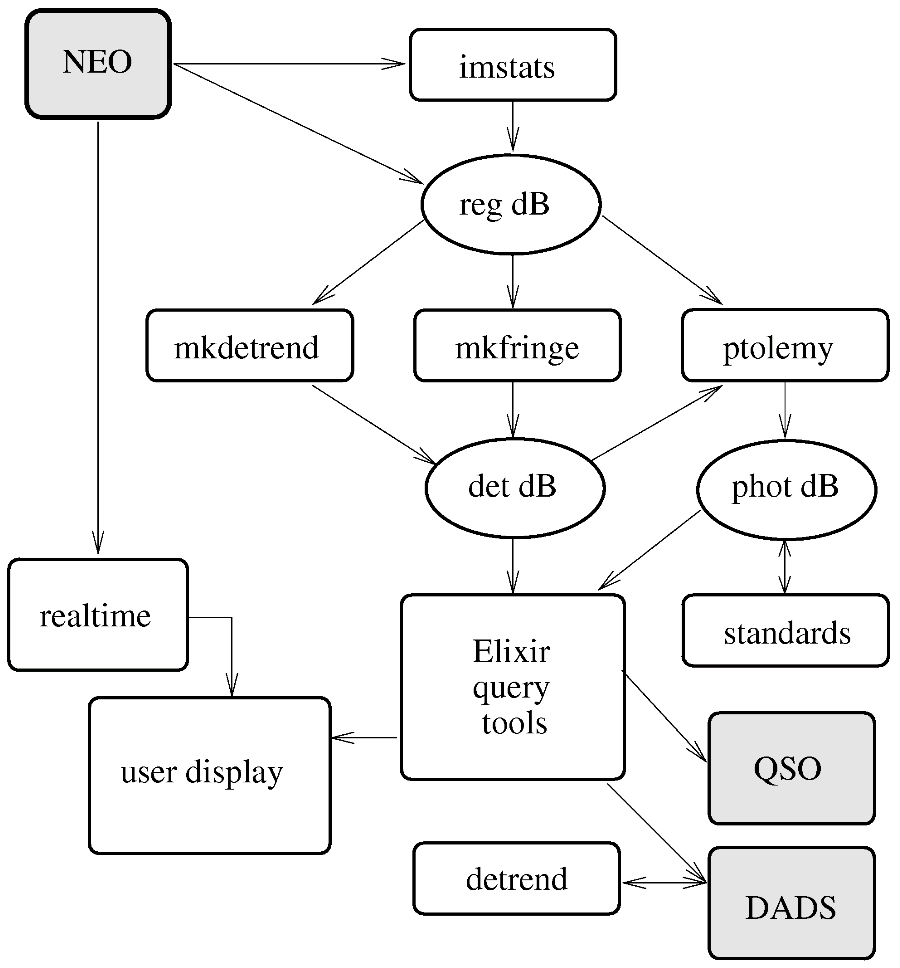| The Elixir System |
|
CFHT introduced the New Observing Program (NOP) in 2001 with the goal of increasing the quality of the data produced at the telescope and delivered to the astronomer. The NOP includes low-level improvements to the camera and telescope interfaces (NEO and TCS IV) which are mostly hidden from the observers, as well as high-level advances in how the data are taken, with the introduction of the Queued Service Observing (QSO). A major component of the NOP is Elixir, an extensive data assessment, calibration, and pre-processing system.
The Elixir system, illustrated below, provides three types of
services: 1) real-time data quality assessment, 2) end-of-run detailed
calibration analysis, 3) image pre-processing and meta-data
compilation for data distribution. Coupled with the data analysis
pipelines are various databases which store all of the necessary data
products. This document provides an overview of the Elixir system
components.
Real-time Analysis The real-time data quality assessment provides quick information to the observers, including the image quality for each image taken, along with tools to make the observations easier: focus analysis plots and real-time data summary plots. In addition, the real-time image statistics pipeline adds data about each image and CCD to a database of image statistics, used by other Elixir systems to select image subsets for further analysis. The real-time system for MegaPrime also includes an analysis pipeline which provides detrended images to the teams involved in the CFHT Legacy Survey supernova searches. Master Detrend Creation The end-of-run analysis starts with the generation of the master detrend frames. The image statistics database is used to select possible input frames which are combined to create master bias, dark, and flat-field images, which are then applied to the original input frames. The Elixir team may then interactively include or exclude a subset of the original input images based on these residual images to generate the best possible master detrend frames, which is then stored in another database. A similar system generates the master fringe frames. Detailed Image Analysis The second stage provides the astrometric calibrations and extracts the stellar photometry. The data processing pipeline for this stage uses the master detrend frames from the previous stage to flatten all of the science images from the camera run. Object detection and instrumental photometry is performed on the flattened images using Sextractor (Bertin \& Arnouts 1996). These objects are used to determine the astrometric solution, by comparison with the USNO 1.0 or other references. The astrometrized object detections are added to the Elixir photometry database system, DVO. Standard Star Analysis The end-of-run analysis also includes the standard star analysis and the determination of the nightly zero points. Observations of standard stars are extracted from the photometry database and used to determine the zero-points for each standard star image. The zero-point values reflect the changes in the night-time transparency, if any, as well as any long-term changes in the telescope or optical transmission. We find that a single airmass and a single, non-varying set of color terms have so far been sufficient to define the standard-star photometry. The Elixir system records the statistics for each standard star frame as well as the statistics from all frames in a filter for each night. These values are saved in separate database tables. Data Distribution The data distribution system uses an Elixir pipeline to perform the image pre-processing, using the best master detrend images available. The same processing pipeline also inserts header keywords giving the astrometric and photometric calibrations determined in the end-of-run stage. The pipeline also generates thumbnail jpeg images which are used by the data processing system to generate a data summary report in a web page interface. |
